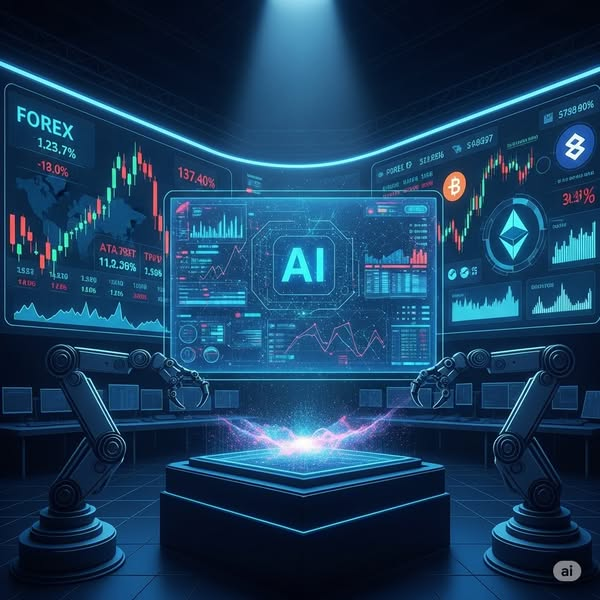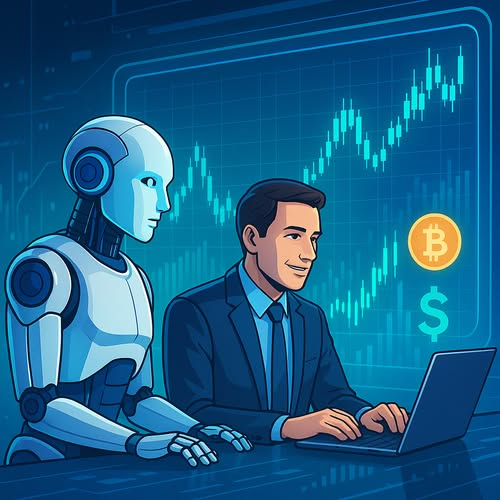Can AI Replace Forex & Crypto Analysts
10
Just a few years ago, real-time analytics, sophisticated trading algorithms, and automated exchange transactions were the exclusive domain of major market players. A successful trader either had a team of technical specialists at their disposal or invested enormous amounts of time manually testing hypotheses, studying code, and analyzing market news.
The advent of AI (ChatGPT, Google Gemini, Microsoft CoPilot, Grok, Claude AI, DeepSeek) has fundamentally transformed this landscape.

Can AI truly replace an entire team of trading assistants? And if so, how exactly does this transformation work? Let’s begin with the more apparent applications.
A New Tool in the Trader’s Arsenal: ChatGPT’s Real Capabilities
According to a ToTheMoon survey, over 36% of retail traders have already integrated AI tools into their workflow, with an additional 28% planning to do so in the near term. Concurrently, research published in ScienceDirect demonstrated that following ChatGPT’s launch, AI-focused crypto assets experienced average gains of 10.7-15.6% within the first month, rising to 35.5-41.3% over two months.
The significance of AI in crypto trading is equally evident in practical applications. The first capability traders notice when integrating GPT into their operations is the model’s ability to translate complex financial terminology into clear, accessible language.
ChatGPT doesn’t merely explain established patterns and switches, or define RSI and moving average strategies – it tailors responses to the user’s expertise level, providing basic analogies for beginners while offering nuanced specifications for experienced traders.
The second valuable function is its capacity to rapidly synthesize news, analytical reports, and social media content. When a trader requests research on a specific coin or market theme, the AI aggregates information from diverse open sources across multiple languages: analytical reports, news platforms, official releases, social media posts, and community discussions on Reddit or X.
Within minutes, users receive a comprehensive brief featuring substantive analysis, key insights, potential market reactions, and comparisons to similar historical precedents.
However, the most influential capability is its ability to formulate trading strategies and simulate scenarios. GPT transforms conceptual ideas into algorithmic logic, selects appropriate indicators, establishes conditional parameters, and even generates corresponding code.
This empowers traders to stay ahead of the curve: developing multiple strategy variants, analyzing potential risks, and conducting thorough backtesting before market deployment – all without external technical expertise.
Developing Conditional Logic and Algorithmic Strategies
ChatGPT enables traders to code with words, articulating trading logic in natural language while the AI translates it into programmatic algorithms. This democratizes algorithmic trading access for those without programming expertise.
Rather than manually writing dozens of lines of entry/exit code, users can describe strategies as Rekt Fencer demonstrated: “Open long when price closes above the upper Bollinger Band, and open short when price drops below the lower band; close long when short conditions appear and vice versa” – prompting ChatGPT to generate complete Pine Script with corresponding entry and exit rules.
Consequently, conditional “if/then” trading logic becomes intelligible to GPT: it interprets described conditions, selects appropriate indicators and functions, and constructs algorithms. Traders need only backtest the results.
GPT also assists during strategy design phases. When traders are uncertain about which indicators or rules to employ, the AI can propose various approaches. According to reviews, ChatGPT successfully generates strategy concepts across different trading styles – from scalping to swing trading.
It can explain which technical indicators work synergistically (such as dual moving averages for trend following, or Bollinger Bands for volatility analysis) and even draft strategy frameworks based on these combinations.

Furthermore, the model can immediately generate strategy code and assist with backtesting. CriptoNoticias traders conducted an experiment requesting four distinct BTC trading strategies from ChatGPT (scalping, day trading, futures, and spot trading) and tested them against historical data.
Results proved mixed – some strategies demonstrated profitability, albeit sometimes only over extended timeframes, while others underperformed. However, in all cases, GPT correctly formulated algorithms and automatically executed backtests in TradingView.
This confirms ChatGPT’s potential as a valuable strategy collaborator that rapidly validates concepts against market history.
Nevertheless, critical analysis from traders remains indispensable – the model lacks market intuition and current data awareness, leaving rule filtration responsibilities with humans.
Best practices suggest integrating GPT recommendations into broader strategy development processes, combining them with personal experience and real-data validation.
Code Generation for TradingView and API-Driven Trading Bots
Another popular application of ChatGPT in crypto trading is the automated generation of code for trading scripts and bots. Traders can request GPT to generate Pine Script code for TradingView or develop Python scripts for exchange API integration.
For instance, developer Michael King documented how he leveraged ChatGPT to build a Binance bot from scratch – the AI immediately provided installation instructions for the Binance library and code for executing BTC purchases through the Binance API. When implementing such bots, it’s essential to choose brokers for trading cryptocurrency that offer robust API access and support automated trading systems.
This approach enables even users without extensive programming knowledge to establish a bot foundation: exchange connectivity, data retrieval, and order execution. In practice, traders have successfully generated Pine Script strategies using GPT.
One Reddit user shared that he simply described the conditions for an RSI divergence strategy (entry upon RSI trendline break and exit on reverse divergence), and ChatGPT generated complete Pine Script strategy code.
According to the author, this strategy proved break-even on the 15-minute BTC/USDT chart (provided the trend maintained sufficient strength, with DMI > 20). Notably, the chatbot dramatically accelerates development processes: tasks that previously required hours of manual coding can now be completed with a single query.
Custom indicators from ChatGPT can also significantly enhance trader efficiency, which proves crucial when operating on shorter timeframes where computational delays are unacceptable. For example, when trading with high leverage and fixed stop-loss values, a chat-generated indicator can calculate order sizing after designating entry and stop-loss points on the chart.
However, code generation represents only the initial step. Generated algorithms require thorough testing and debugging.
ChatGPT may introduce syntax or logical errors, so success rarely comes on the first attempt, often necessitating multiple iterations of copying error messages back to ChatGPT (the model typically offers corrected code) or supplementing requests with additional conditions.
In essence, ChatGPT excels at drafting bots or indicators, but human traders must assume the role of quality assurance, refining scripts to production standards. It’s also crucial to recognize that trading strategy risks remain with the user: even with correct code, initial trading should be conducted on paper or testnet environments, or by using forex bonuses without a deposit to test AI-generated strategies in live market conditions without capital risk.
Comparative Statistics: Traditional Approach vs AI
When we talk about AI in trading, it sounds fantastic in theory, but the real impact truly hits home when you look at the numbers. The difference in trading costs is pretty astounding: what used to cost a whopping six figures a year for human experts can now be done for less than your monthly gym membership.
And let’s talk about speed. Old-school analysts need hours, sometimes even days, to dig through market data and come up with a plan. But AI? It crunches all that info and gives you a full analysis in minutes.
This isn’t just about saving time; it opens up brand new trading opportunities, which is super important in today’s wild crypto markets where timing is everything.
However, the data also clearly shows where AI falls short. It can’t see real-time market action or fully grasp all the little nuances, meaning AI can’t completely replace human decision-making. So, the best approach seems to be a hybrid model: use AI for its raw processing power and cost savings, but keep human oversight for that crucial market intuition and managing risks.
For everyday traders, this comparison is huge. It means powerful trading tools that were once only for big institutions are now available to everyone, really leveling the playing field in the market.
| Aspect | Traditional Human Analysts | AI Tools (ChatGPT) |
|---|---|---|
| Speed | Hours to days for analysis | Minutes to seconds |
| Cost | $50,000-150,000+ annually | $20-100/month |
| Availability | Business hours only | 24/7 accessibility |
| Emotional Bias | Subject to fear/greed cycles | Objective, emotion-free analysis |
| Market Intuition | High (experience-based insights) | Limited contextual understanding |
| Data Processing | Limited scope and speed | Vast datasets, multiple languages |
| Real-time Data | Full market access | No direct live data access |
| Code Generation | Requires programming skills | Natural language to code |
| Strategy Backtesting | Manual, time-intensive | Automated, rapid testing |
| Learning Curve | Years of experience required | Immediate accessibility |
| Accountability | Professional liability | No responsibility for losses |
| Customization | Fully personalized approach | Generic responses, require specific prompts |
Optimizing Indicators and Identifying Trading Setups
Another significant application for ChatGPT lies in optimizing existing trading strategies and indicators. Given a basic algorithm or a set of rules, a trader can prompt the AI to analyze it and suggest improvements.
For instance, specialized GPT assistants, specifically designed for Pine Script, not only generate code but also analyze a strategy’s risk-to-reward ratio and provide recommendations for its optimization. GPT can advise on adjusting indicator parameters (such as RSI periods or moving average lengths) based on desired outcomes or identified issues.
Pepperstone’s website highlights a common practice: after backtesting a strategy, a trader might ask ChatGPT how to reduce drawdown or enhance signal exclusivity. The model could, for example, suggest adding another indicator as a filter or strengthening an exit rule.
In this way, GPT serves as an optimization consultant, reviewing a preliminary strategy and pinpointing areas for enhancement.
When it comes to indicators, ChatGPT also assists traders in selecting optimal indicators or combinations for specific market regimes. It can analyze a textual description of a situation (e.g., “a flat market with low volatility”) and recommend which indicators would perform best (e.g., oscillators instead of trend-following indicators), complete with explanations.
Furthermore, ChatGPT is capable of interpreting indicator results and chart patterns. Through its training on extensive financial datasets, it can recognize classic patterns (like head and shoulders or triangles) and comment on their potential implications.
By uploading a chart screenshot to ChatGPT (via features available in ChatGPT Plus), the model can analyze the layout, identify support/resistance levels, trends, and indicate signals from popular indicators. While this doesn’t guarantee an infallible forecast, it offers a valuable way to quickly obtain a fresh perspective on your technical analysis.
Observers note that GPT can suggest how to combine multiple indicators for greater signal precision or what to look for in current chart patterns. Traders are already leveraging these capabilities for market screening; for instance, they might ask the AI to generate a list of potential trading setups based on recent data.
While ChatGPT doesn’t have access to live prices, providing it with an extract from a recent exchange feed enables the model to generate several possible price scenarios.
It’s crucial to understand that optimization with ChatGPT is an iterative process. The model can refine what you provide, but if the initial concept was flawed, the optimized version won’t necessarily become profitable.
Therefore, all recommendations require practical validation.
The advantage of AI lies in its ability to rapidly generate alternatives: you can test several proposed indicator parameters and select the best-performing one. This process, which once involved days of manual iteration, is now reduced to hours.
Thus, GPT accelerates a trader’s learning curve, enabling faster discovery of viable setups, but the ultimate decision and responsibility still rest with the individual.
Limitations to Acknowledge and Rules to Follow
Despite its myriad capabilities, ChatGPT remains a tool, not a guarantor of results. To extract maximum value from it, it’s essential to clearly understand its limitations and adhere to some straightforward guidelines.
First and foremost, remember that ChatGPT does not have direct access to live exchange charts or real-time prices. It cannot observe market behavior as it unfolds. If you want the AI to analyze a specific market situation, you’ll need to manually provide the data, whether it’s a description, a screenshot, or historical data.
While this may not always be convenient, it allows for an alternative perspective on information you already possess.
The second limitation is generalization. GPT formulates responses based on statistical patterns from the texts it was trained on. Consequently, its answers might lack the specific nuances inherent to your strategy or market conditions. It doesn’t comprehend your emotional resilience, risk tolerance, or trading style.
This means your prompts must be as precise as possible: specify the asset, timeframe, trade type, and entry/exit conditions. A truly effective answer stems from a highly specific question.
Finally, GPT bears no responsibility. Any advice from the AI chat should never be construed as financial guidance. It doesn’t account for slippage, commissions, delays, or market psychology. The ultimate decision always rests with you.
To use GPT effectively, consider the following principles:
- Test everything you create – start with a demo account or backtesting.
- Work iteratively: avoid building complex strategies all at once. Add one condition, test it, then move on to the next.
- Save prompts that yield good results.
- Use GPT not only for creating strategies, but also for analyzing your trades.
- Document your entry/exit logic and review what went wrong – this is the best way to learn, both for the trader and the AI assistant.

All these “analysts” forget one thing: black swan events. AI only knows what happened in the past. It cant predict a sudden war or a bank failing. I’ll stick to my own eyes and manual charts, thank u very much. Too risky.
Hybrid model is definitely the way.
I use AI to filter stocks and crypto pairs, then I do the chart analysis myself…. Its like having a junior analyst working for free 24/7…. Cant complain about that, it helps filter out the noise so i can focus on high probability setups.
Love this! 🚀 AI and machine learning is exactly what we need to beat the whales. Great insights on the crypto part, very helpful.
The line between human intuition and algorithmic precision is blurring. This article highlights a shift in market psychology. If everyone uses the same AI models, won’t the edge eventually disappear?
Just a thought.
solid points. backtesting is key tho. if your ai analyst doesnt show sharpe ratio and max drawdown stats, its just a fancy toy. been devving my own scripts and its harder than it looks.
Im new to this… is it safe to connect my exchange to these AI tools?? the article says they are good but i am scared of hacks. anyone here can recomend a safe one?
Idk man, i dont trust these bots fully yet.
they dont “feel” the market like a real person. sure they can proces data fast but can they panic when feds drop rates?
nope.
ill stick to my own charts thanks. maybe for backtesting its ok but not for live trading with my hard earned cash.
I tried one of these “smart” analysts last month.
Lost 15% of my deposit in 3 days because of some glitch in the API.
Be careful guys, AI is not a magic money machine.
You still need to watch the news.
nice info. help me understand crypto bots more. some terms are hard but generaly i like the text. thnx!
Good summary but you missed the importance of “hybrid trading”. AI should find the setups, but humans should pull the trigger. Never go 100% auto. My 10 years experience tells me data + gut feeling = profit.